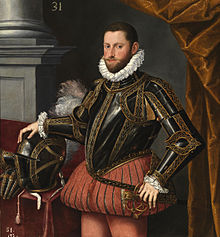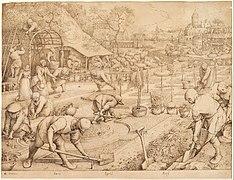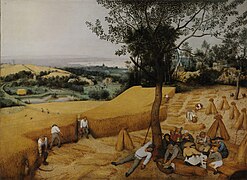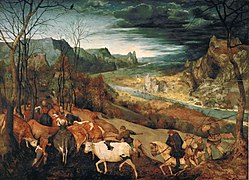Archduke Ernest of Austria
 From Wikipedia - Reading time: 9 min
From Wikipedia - Reading time: 9 min
This article relies largely or entirely on a single source. (October 2012) |
| Ernest of Austria | |
|---|---|
 Portrait by Martino Rota c. 1580 | |
| Born | 15 June 1553[1] Vienna, Archduchy of Austria |
| Died | 20 February 1595 (aged 41)[1] Brussels, Duchy of Brabant |
| House | Habsburg |
| Father | Maximilian II, Holy Roman Emperor |
| Mother | Maria of Spain |

Archduke Ernest of Austria (German: Ernst von Österreich; 15 June 1553 – 20 February 1595)[1] was an Austrian prince, the son of Maximilian II, Holy Roman Emperor, and Maria of Spain.
Biography
[edit]Born in Vienna, he was educated with his brother Rudolf II, Holy Roman Emperor, in the court of Spain.[1] He was a candidate in the 1573 Polish–Lithuanian royal election for the throne of Poland. He lost his election as the Polish nobility feared that he might attempt to become an autocrat and revoke the privileges that Polish nobles enjoyed.[2] From 1576 onwards, he was governor in the Archduchy of Austria, where he promoted the Counter-Reformation. In 1590, he became governor of Inner Austria as regent for his young cousin Ferdinand, and from 1594 to 1595 he served as Governor of the Spanish Netherlands.
He died in Brussels on 20 February 1595 and was eventually succeeded in the Netherlands by his brother Albert. Ernest owned the Months of the Year cycle series of works painted by Pieter Bruegel the Elder; one painting, High Spring (showing April or May) is lost):
-
The Gloomy Day (February/March)
-
A 1565 Brugel sketch "Spring" although not part of the Months cycle series it could very well be similar to what Bruegel had in mind when he painted "High Spring" {April/May)
-
The Hay Harvest (June/July)
-
The Harvesters (August/September)
-
The Return of the Herd (October/November)
-
The Hunters in the Snow (December/January)
Ancestry
[edit]| Ancestors of Archduke Ernest of Austria | |||||||||||||||||||||||||||||||||||||||||||||||||||||||||||||||||||||||||||||||||||||||||||||||||||||||||||||||||||||||||||||||||||||||||||||||||||||||||||||||||||||||||||||||||||||||||||||||||||||||||||||||||||||||||||||||||||||||||||||||||||||||||||||||||||||||||||||||||||||||||
|---|---|---|---|---|---|---|---|---|---|---|---|---|---|---|---|---|---|---|---|---|---|---|---|---|---|---|---|---|---|---|---|---|---|---|---|---|---|---|---|---|---|---|---|---|---|---|---|---|---|---|---|---|---|---|---|---|---|---|---|---|---|---|---|---|---|---|---|---|---|---|---|---|---|---|---|---|---|---|---|---|---|---|---|---|---|---|---|---|---|---|---|---|---|---|---|---|---|---|---|---|---|---|---|---|---|---|---|---|---|---|---|---|---|---|---|---|---|---|---|---|---|---|---|---|---|---|---|---|---|---|---|---|---|---|---|---|---|---|---|---|---|---|---|---|---|---|---|---|---|---|---|---|---|---|---|---|---|---|---|---|---|---|---|---|---|---|---|---|---|---|---|---|---|---|---|---|---|---|---|---|---|---|---|---|---|---|---|---|---|---|---|---|---|---|---|---|---|---|---|---|---|---|---|---|---|---|---|---|---|---|---|---|---|---|---|---|---|---|---|---|---|---|---|---|---|---|---|---|---|---|---|---|---|---|---|---|---|---|---|---|---|---|---|---|---|---|---|---|---|---|---|---|---|---|---|---|---|---|---|---|---|---|---|---|---|---|---|---|---|---|---|---|---|---|---|---|---|---|---|---|---|
| |||||||||||||||||||||||||||||||||||||||||||||||||||||||||||||||||||||||||||||||||||||||||||||||||||||||||||||||||||||||||||||||||||||||||||||||||||||||||||||||||||||||||||||||||||||||||||||||||||||||||||||||||||||||||||||||||||||||||||||||||||||||||||||||||||||||||||||||||||||||||
Male-line family tree
[edit]References
[edit]- ^ a b c d Wurzbach, Constantin von, ed. (1860). . Biographisches Lexikon des Kaiserthums Oesterreich [Biographical Encyclopedia of the Austrian Empire] (in German). Vol. 6. p. 180 – via Wikisource.
- ^ Roşu, Felicia (2017). Elective monarchy in Transylvania and Poland-Lithuania, 1569-1587. Oxford, United Kingdom: Oxford University Press. ISBN 978-0-19-878937-6. OCLC 990854634.
- ^ a b Press, Volker (1990), "Maximilian II.", Neue Deutsche Biographie (in German), vol. 16, Berlin: Duncker & Humblot, pp. 471–475; (full text online)
- ^ a b Wurzbach, Constantin von, ed. (1861). . Biographisches Lexikon des Kaiserthums Oesterreich [Biographical Encyclopedia of the Austrian Empire] (in German). Vol. 7. p. 19 – via Wikisource.
- ^ Wurzbach, Constantin von, ed. (1861). . Biographisches Lexikon des Kaiserthums Oesterreich [Biographical Encyclopedia of the Austrian Empire] (in German). Vol. 7. p. 112 – via Wikisource.
- ^ Chisholm, Hugh, ed. (1911). . Encyclopædia Britannica. Vol. 15 (11th ed.). Cambridge University Press.
- ^ a b Priebatsch, Felix (1908), "Wladislaw II.", Allgemeine Deutsche Biographie (in German), vol. 54, Leipzig: Duncker & Humblot, pp. 688–696
- ^ a b Charles V, Holy Roman Emperor at the Encyclopædia Britannica
- ^ a b Stephens, Henry Morse (1903). The story of Portugal. G.P. Putnam's Sons. pp. 125, 139, 279. ISBN 9780722224731. Retrieved 11 July 2018.
 KSF
KSF




